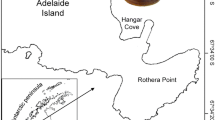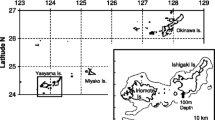Abstract
Ficopomatus enigmaticus, a polychaete inhabiting the subtidal zone in the Mar Chiquita coastal lagoon, builds reef-like aggregates that facilitate silt accumulation. To describe the life cycle, samples were take monthly from September 1984 to September 1985. In contrast with other polychaetes, it has two oocyte generations per year; maturation of the oocytes takes approximately 4 mo. Temperature level and day length regime do not appear as environmental signals to the onset of oogenesis, although they possibly affect oogenesis growth. Two periods of spawning and recruitment were observed in November–December and April–May, when water temperature is above 18°C. Hermaphroditic individuals were not found. Sex ratio was male-biased in all months, significantly in November, February, and August (p<0.001). Monthly size-frequency distributions show distinct year-classes with early (November–December) and late (April–May) recruitment. Early recruited cohorts have two spawning periods during a 24-mo lifespan. Late cohorts have one spawning period during their 20-mo lifespan. The life cycle of this species can be summarized as follows: annual iteroparous—1 to 2 batches of small eggs per female during each lifespan, free spawning, planktotrophic larvae, sedentary suspension-feeder worms.
Similar content being viewed by others
Literature Cited
Chambers, M. R. andH. Milne. 1975. Life cycle and production ofNereis diversicolor O.F Muller in the Ithan estuary, Scotland.Estuarine and Coastal Marine Science 3:133–144.
Dales, R. P. 1950. An annual history of a population ofNereis diversicolor O.F Muller.Biological Bulletin 101:131–137.
Dixon, D. 1980. The energetics of growth and reproduction in the brackish water SerpulidMercierella enigmatica (Fauvel), p. 197–209.In G. Personee and E. Jaspers (eds.), Proceedings of the 10th European Symposium on Marine Biology. Universa Press, Belgium.
Dixon, D.. 1980. The energetics of tube production byMercierella enigmatica (Polychaeta:Serpulidae).Journal of the Marine Biological Association U.K. 60:655–659.
Dixon, D. 1980. Reproductive biology of the SerpulidFicopomatus (Mercierella) engimaticus in the Thames estuary, S.E. England.Journal of the Marine Biological Association U.K. 61:805–815.
Duchène, J. C.. 1979. Premieres donnèes sur la reproduction et la croissance de la polycheteThelepus setosus (Terebellidae) en province subantartique.Annales Institut Oceanographique Paris 55:145–154.
Duchène, J. C. 1980. Premieres donnèes sur la reproduction et la croissance de la polycheteNeoleprea streptochaeta (Terebellidae) en province subantartique.Annales Institut Oceanographique Paris 56:109–115.
Elkaim, B. andJ. P. Irlinger. 1987. Contribution a l’etude de la dynamique des populations dePectinaria koreni Malmgren (Polychete) en Baie de Seine Orientale.Journal of Experimental Marine Biology and Ecology 107:171–197.
Fauchald, K. 1983. Life diagram patterns in benthic polychaetes.Proceedings of the Biological Society of Washington 96:160–177.
Fauvel, P. 1923. Un nouveau serpulien d’eau saumatreMercierella n.g.enigmatica n.sp.Bulletin de la Sociètè Zoologique de France 46:424–430.
Fauvel, P.. 1925. L’opercule de laMercierella engimatica Fauvel (Annelide: Polychete) et la pretendue incubation operculaire.Bulletin du Museum National d’Histoire Naturelle 3:237–242.
Fischer-Piette, E.. 1937. Sur la biologie du Serpulien d’eau saumatreMercierella enigmatica Fauvel.Bulletin de la Sociètè Zoologique de France 62:197–208.
Grant, A., P. J. Morgan, andP. J. W. Olive. 1987. Use made in marine ecology of methods for estimating demographic parameters from size-frequency data.Marine Biology 95:201–208.
Gruet, Y.. 1982. Recherches sur l’ecologie des “recifs” d’Hermelles edifies par l’annelide polycheteSabellaria alveolata (Linnè). Thesis, Institut des Sciences de la Nature, Nantes. 238 p.
Heip, C. andR. Herman. 1979. Production ofNereis diversicolor O.F Muller (Polychaeta) in a shallow brackish water pond.Estuarine and Coastal Marine Science 8:297–305.
Hill, M. B. 1967. The life cycle and salinity tolerances of the seruplidsMercierella enigmatica Fauvel andHydroides uncinata (Phillipi) at Lagos, Nigeria.Journal of Animal Ecology 36:303–322.
Karlin, S. andS. Lessard. 1986. Theoretical Studies on Sex Ratio Evolution. Princeton University Press, Princeton, New Jersey. 313 p.
Keene, W.. 1981. The importance of reef-forming polychaete,Mercierella enigmatica Fauvel, in the oxygen and nutrients dynamics of a hypereutrophic subtropical lagoon.Estuarine and Coastal Marine Science 2:167–178.
Kristensen, E.. 1984. Life cycle, growth, and production in estuarine population of the polychaetesNereis virens andNereis diversicolor.Holoartic Ecology 7:249–256.
MacDonald, P. D. andT. J. Pitcher. 1979. Age-groups from size frequency data: A versatile and efficient method of analyzing distribution mixtures.Journal of the Fisheries Research Board of Canada 36:987–1001.
McNulty, J. K. andN. N. Lopez. 1969. Year-round production of ripe gametes by benthic polychaetes in Biscayne Bay, Florida.Bulletin of Marine Science 19:945–954.
Mettam, C.. 1979. Seasonal changes in populations ofNereis diversicolor O.F. Muller from the Severn Estuary, U.K.. p. 123–130.In E. Naylor and R. Hartnoll (eds.), Cyclic Phenomena in Plants and Animals. Pergamon Press, New York.
Obenat, S. andS. Pezzani. 1989. Ecological studies ofFicopomatus (Mercierella) enigmaticus (Annelida: Polychaeta) in Mar Chiquita coastal lagoon (Buenos Aires, Argentina), p. 165–166.In Conservation and Development: The Sustainable Use of Wetland Resources. Third International Wetlands Conference. Editions du Musèum National d’Histoire Naturelle, Paris.
Olive, P. J. W. andP. R. Garwood. 1981. Gametogenic cycle and population structure ofNereis (Hediste) diversicolor andNereis (Nereis) pelagica from northeast England.Journal of Marine Biological Association U.K. 61:193–213.
Olive, P. J. W., P. J. Morgan, N. H. Wright, andS. L. Thang. 1984. Variable reproductive output in polychaeta: Options and design constraits, p. 399–408.In W. Engels (ed.), Advances in Invertebrates Reproduction. Elsevier, New York.
Olivier, S. R., A. Escofet, P. Penchaszadeh, andJ. M. Orensanz. 1972a. Estudios ecologicos de la region estuarial de la Albufera Mar Chiquita. I. Las comunidades bentonicas.Anales Sociedad Cientifica Argentina 193:237–262.
Olivier, S. R., A. Escofet, P. Penchaszadeh, andJ. M. Orensanz. 1972b. Estudio ecológicos de la region estuarial de Mar Chiquita (Buenos Aires, Argentina). II. Relaciones tróficas interespecíficas.Anales Sociedad Cientifica Argentina 194:89–94.
Orensanz, J. M. andM. C. Estivariz. 1971. Los anélidos poliquetos de aguas salobres de la Provincia de Buenos Aires.Revista del Museo La Plata, Universidad Nacional de La Plata XI: 95–112.
Petit, G. andF. Rullier. 1952.Mercierella enigmatica Fauvel sur les cotes de la Mediterraneè francaise. Observations sur deux stations nouvelles du littoral des Pyreneès-Orientales.Vie et Milieu 3:1–19.
Pezzani, S. and S. Obenat. 1988. Estudio integrado de la laguna costera mar Chiquita, Provincia de Buenos Aires, Argentina. I. Características de la población deFicopomatus enigmaticus, p. 101–102.In Informe UNESCO Ciencias Marinas No. 47.
Rullier, F.. 1955. Developpement du SerpulienMercierella enigmatica Fauvel.Vie et Milieu 6:225–240.
Taylor, B.. 1965. The analysis of polimodal frequency distributions.Journal of Animal Ecology 34:445–452.
Straughan, D.. 1972b. Ecological studies ofMercierella enigmatica Fauvel (Annelida: Polychaeta) in the Brisbane River.Journal of Animal Ecology 41:93–136.
Straughan, D.. 1972b. The influence of seasonal rainfall and water temperature on the population ofMercierella enigmatica Fauvel (Annelida: Polychaeta) in the Ross River estuary, North Queensland.Journal of Experimental Marine Biology and Ecology 9:165–172.
ten Hove, H.. 1974. Notes onHydroides elegans (Haswell, 1883) andMercierella enigmatica (Fauvel, 1923), alien Serpulid polychaetes introduced into the Netherlands.Bulletin Zoologisch Museum, Universiteit van Amsterdam 4:45–52.
ten Hove, H.. 1979. Tube worm, p. 400–402.In Encyclopedia of Science and Technology. McGraw Hill Inc., London.
ten Hove, H. andJ. C. Weerdenburg. 1978. A generic revision of the brackish water SerpulidFicopomatus Southern 1921 (Polychaeta: Seruplinae) includingMercierella Fauvel 1923,Sphaeropomatus Treadwell 1934,Mercierellopsis Rioja 1945, andNeopomatus Pillai 1960.Biological Bulletin 154:96–120.
Vuillemin, S. 1965. Contribution a l’etude ècologique de Lac de Tunis: Biologie deMercierella enigmatica Fauvel. Thesis, Paris, Ser. A, No. d’ordre 5469.
Wenner, A.. 1972. Sex ratio as a function of size in marine crustacea.American Naturalist 106:321–351.
Wildish, D. J.. 1977. Biased sex ratios in invertebrates, p. 8–24.In Adiyodi and Adiyodi (eds.), Advances in Invertebrate Reproduction, Vol. 1. Elsevier North Holland Inc., Netherlands.
Wilson, D. P.. 1970. The larvae ofSabellaria spinulosa and their settlement behaviour.Journal of Marine Biological Association U.K. 50:1–33.
Wilson, W. H.. 1991. Sexual reproductive modes in polychaetes: Classification and diversity.Bulletin of Marine Science 48:500–516.
Zajac, R. andR. Whitlatch. 1988. Population ecology of the polychaeteNephtys incisa in Long Island Sound and the effect of disturbance.Estuaries 11:117–133.
Author information
Authors and Affiliations
Rights and permissions
About this article
Cite this article
Obenat, S.M., Pezzani, S.E. Life cycle and population structure of the polychaeteFicopomatus enigmaticus (Serpulidae) in Mar Chiquita coastal lagoon, Argentina. Estuaries 17, 263–270 (1994). https://doi.org/10.2307/1352574
Received:
Accepted:
Issue Date:
DOI: https://doi.org/10.2307/1352574




